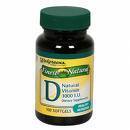All Cause Mortality Linked to Vitamin D Deficiency
by
Joan Trombetti, Writer | August 12, 2008

Low Vitamin D levels may raise
the risk of death from any cause
Researchers have found that low vitamin D levels may raise the risk of death from any cause. Vitamin D deficiency was associated with an increased all-cause mortality risk by 26% compared with optimal levels (below 17.8 versus above 32.1 ng/mL), reported Michal L. Melamed, M.D., of Albert Einstein College of Medicine here, and colleagues in the August 11 issue of the Archives of Internal Medicine.
This association in the observational population-based study was independent of lifestyle measures and cardiovascular risk factors and could not be pinned down to any single cause of death.
If these findings are confirmed, vitamin D supplementation should be studied as a way to reduce mortality risk, the researchers said.
Action Points
* Note that vitamin D levels above 30 ng/mL considered optimal are not achieved by at least half of the adult population.
* Caution patients that although the study reinforces the link between mortality and vitamin D levels, the observational design could not determine whether the relationship was causal.
Other studies have also linked vitamin D status to cardiovascular disease, cancer and death in heart disease patients, dialysis patients, and other specific populations. However, vitamin D levels below the optimal 30 ng/mL or greater level are common in the general population. About 41% of American men and 53% of women have vitamin D concentrations below 28 ng/mL. So the researchers analyzed data from 13,331 adults ages 20 and older in the nationally representative National Health and Nutrition Examination Survey (NHANES III).
Serum vitamin D was measured at baseline from 1988 through 1994. Deficiency was defined in the study by the lowest 25-hydroxyvitamin D quartile, which had levels below 17.8 ng/mL. Adults who reported more physical activity or vitamin D supplementation or were assessed in a non-winter season were less likely to be deficient.
In the multivariate analysis, factors associated with elevated risk for vitamin D deficiency were older age, female sex, nonwhite race or ethnicity, diabetes, smoking, and higher body mass index.
During a median 8.7 years of passive follow-up of mortality, 1,806 participants died.
The largest proportion of deaths (43%) was from cardiovascular causes, primarily atherosclerotic cardiovascular disease (76%). Cancer was the second leading cause of death (23%).
All-cause mortality was 26% higher among those in the lowest vitamin D quartile compared with those in the highest quartile with optimal vitamin D status above 32.1 ng/mL after controlling for baseline demographics, season when vitamin D was measured, and traditional and novel cardiovascular risk factors (mortality rate ratio 1.26, 95% CI 1.08 to 1.46).
